
 |
|
|
#41 (permalink) | ||
|
Crazy
Location: Los Angeles, CA
|
Quote:
 Also host, I see red Xs in place of the pics in that last post, could you repost (or in the event it's a problem on my end) suggest how I can view them? (I can see the pics in your previous posts, just the last one is the problem) Quote:
 ) the easier question to answer regarding the damage descriptions in the NIST report. ) the easier question to answer regarding the damage descriptions in the NIST report. The fire intensity I suspect will be the most difficult to answer, so I will dig into the collapse mechanic first. |
||
|
|
|
|
#42 (permalink) | |
|
|
Quote:
So we should not use those two photographs (in the state that we have them - i.e. without times) together, without any further evidence, with regards to amount of damage or as proof of a cover up. OK, I am going to take a look at the rest of what was posted since back then in the therad.
__________________
Sticky The Stickman |
|
|
|
|
|
#43 (permalink) | |||
|
Crazy
Location: Los Angeles, CA
|
Question 3) Symmetrical Collapse from Asymmetrical Damage?
(I apologize, much as I tried to distill my reasoning, this is still a long post) As I said in previous posts, I do not believe that the damage to the south face was the cause of collapse. The collapse initiation cause and location may well never be answered to a certainty, but the information and hypotheses available regarding the collapse mechanic and why the building stayed close to it's footprint is compelling. From the current NIST status summary posted by host in post #31 (http://wtc.nist.gov/media/WTC7_Appro...ec07-Final.pdf) Quote:
The video below shows a real-time collapse of WTC7 from a Northeastern view: Using my highly newbie screen capturing/annotation skills, I grabbed some shots that were of interest (yellow text is from the video, green annotations are mine): Between the 4 and 5 second mark, the East penthouse begins to collapse. While it is possible that the failure began from the top and progressed downward , it seems more sensible that the failure began at a lower floor some time before this (since there is more weight to be supported the lower the floor, and it was the lower floor structural members that may have been subject to heating). This seems to support the "vertical progression of failure" in the hypothesis. 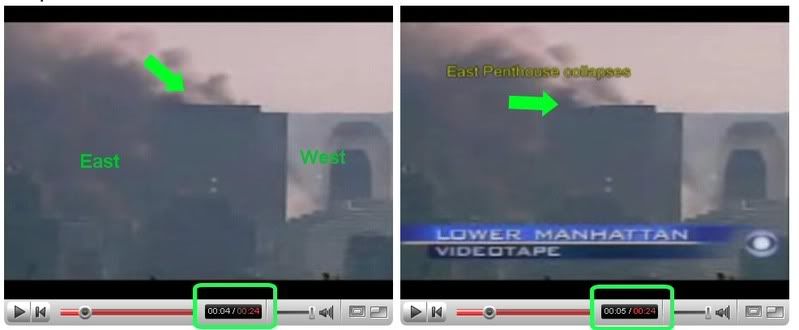 Between the 6 and 11 second mark, nothing appears to be happening externally. However, it is sensible to presume that some areas are still settling, and it is certain that the load of all the collapsed floors is now being distributed to the remaining columns on the West side. 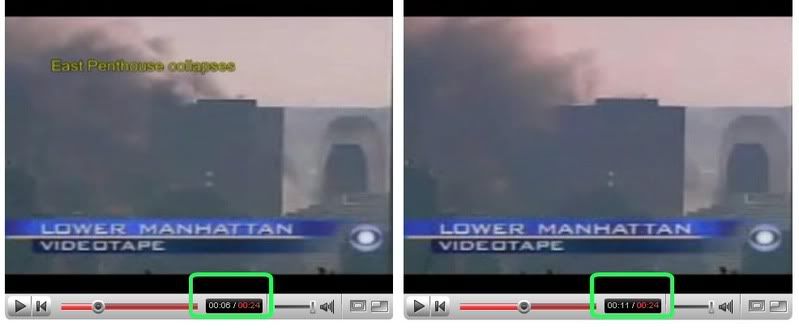 Sometime between the 11 and 12 second mark, the West penthouse begins to collapse from the middle of the building towards the west, as evidenced by the tilt of the penthouse as it collapses through the roof. This tilt would seem to bolster a "horizontal progression of failure" in the hypothesis. 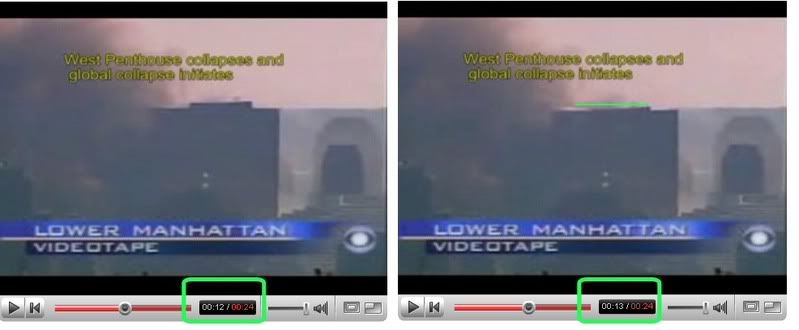 Another annotated picture that might be a little clearer: 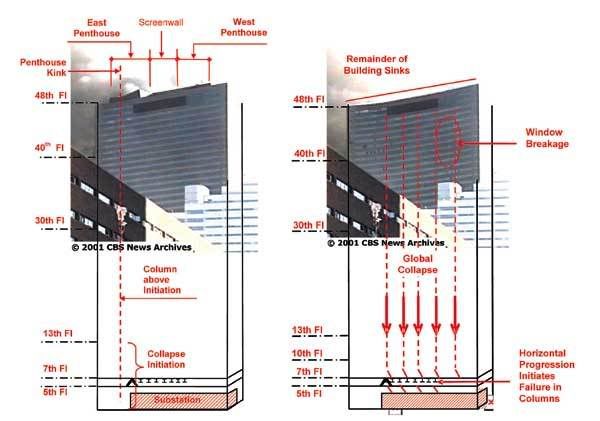 My unofficial count from the time the penthouse is first seen to collapse (4-5 second mark) to the time it is about to leave the frame (17 second mark) is 12-13 seconds, which matches the value annotated in the video. Since the building has not hit the ground yet, and since we do not know at what point the collapse started before we see the east penthouse begin to sink, it is reasonable to assume that the entirety of the collapse mechanic was longer than 13 seconds. 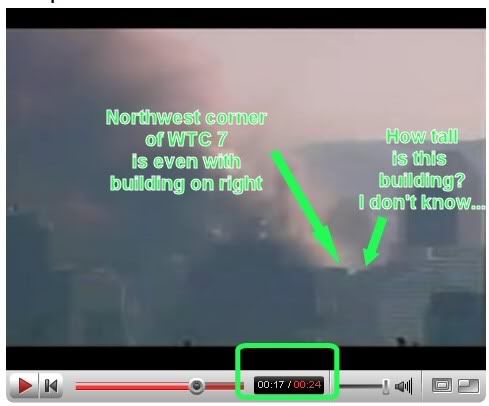 Structure Magazine released an article in their November issue in which they commented on the WTC7 collapse, and modelled the building in order to try to determine the most likely member that failed. While it is safe to assume that their model was not nearly as detailed as the NIST one will be, their conclusions offer support to the hypothesis as well: Article: http://www.structuremag.org/Archives...sanz-Nov07.pdf Quote:
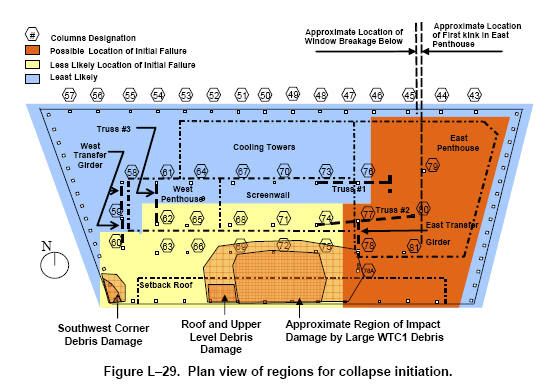 Simulated model still (from page 4 of the article): 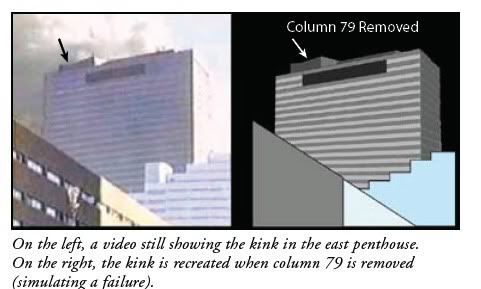 Based on the video evidence and the findings in the Structure Mag article, I don't think it unreasonable that the NIST hypothesis as to the method of collapse is incorrect, specifically that WTC7 collapsed due to an internal column failure which led to global collapse, and that a small footprint is indicative of such an internal failure (because the floors would be bringing the walls down on top of them). Quote:
1) the fires themselves were sufficient to initiate a collapse; 2) they ignited something else that finally initated a collapse (fuel tanks or transformers?); 3) A combination of 1) and 2) (However, as you posted NIST has discarded any fuel other than typical office items, so 2) and 3) would be an unlikely area to research); 4) A combination of the south face damage plus the fires contributed to the collapse. 5) None of the above (other) I don't believe that there will ever be a 100% certainty as to the initiation cause or the exact location of initiation, only a high-percentage possibility. But I've invested this much time into it so I'm going to dig into the fire aspect as time permits just to satisfy my own curiosity  |
|||
|
|
|
|
#44 (permalink) | |
|
Crazy
Location: Los Angeles, CA
|
2) Were the fires in WTC 7 responsible (either partially or completely) for it's eventual collapse?
As I said in earlier posts, this was the question I believed would be the hardest to research and present. As host pointed out, the NIST investigation is focusing on "normal building fires" as a hypothetical cause for the event. Using that as a basis, I dug into a variety of information, and I struggled with how to present the information in a way that is concise - I don't know if I will meet that goal, but I am going to attempt to boil down the info and interpretation as much as possible - I will try to tie it all together at the end I promise  ~~~~~~~~~~~~~~~~~~~~~~~~~~~~~~~~~~ From the Technical Approach Summary of Dec. 18 (http://wtc.nist.gov/media/WTC7_Appro...c07-Final.pdf), NIST is investigating "fire events" and "hypothetical blast events" as the possible initiating causes of collapse. Since the NIST investigation is not complete, this is presented as a question of "does the [fire events] hypothesis agree with observed events?" ~~~~~~~~~~~~~~~~~~~~~~~~~~~~~~~~~~ a) Time and magnitude of fires in WTC7. The collapse of WTC1 is thought to have been an initiating mechanism for the fires in building 7. Fire crews were not sent into the building, and as such the fires were free to burn for approximately 7 hours before the ultimate collapse. From the FEMA report fires were known to be on floors 6,7,8,10,11, and 19 (http://www.fema.gov/pdf/library/fema403_ch5.pdf page 20). Evidence that that fires continued during that time and got bigger: a1) A picture taken from the southeast sometime after the collapse of the towers. The light reflecting on the east faces of the buildings would point to the time being before noon. Note that there is very little smoke emanating from building 7 (tall building to the right): 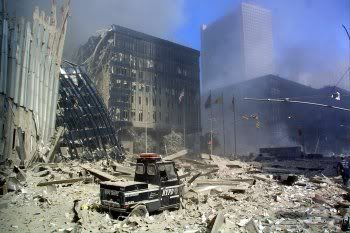 a2) A picture taken from the southwest. The light on the west walls indicate that it is later in the day. Note the smoke pouring from the south face of the building. This would indicate that the fires have increased, and also indicates that the wind is blowing from the north to south, so we are not looking at dust from either of the towers, since they are south of building 7. 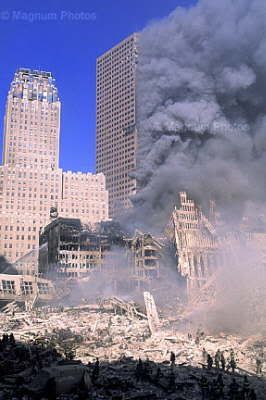 a3) Two pictures taken from the Northeast at different times (left picture is earlier, noted by the people in the frame, right picture is later, noted by the absence of people in the frame. Note that the fire has progressed toward the north of the building, and note specifically that this is from the East side of the building, the area in which it appears the collapse initiated and caused the penthouse to sink before total collapse ensued.  ~~~~~~~~~~~~~~~~~~~~~~~~~~~~~~~~~~ b) Temperature of room/structure fires. Like Will, I had trouble finding reliable information on temperatures in a structure fire. Since fire heats objects via conduction (flame impingement on object), convection (flame heats air or other meduum which then heats object), and radiation (energy transfers to objects, much like the sun heating asphalt), where do you measure temperature? b1) We can look at ASTM E119, which is a test adopted intially in 1918 (http://www.iaei.org/subscriber/magaz...d/berhinig.htm 3rd paragraph) used by building codes in the USA to determine acceptable fire ratings based on a time temperature curve. The curve used by the test presumes a temperature increasing over time that approaches the flame temperature of a fire fueled by typical fuel sources that is not subjected to any sources of cooling, and peaks at 1260 degrees C after 8 hours. Now, no structure fire is a closed system with no cooling mechanism, and building codes recognize this by making the highest rating only need to survive for a 4 hour period of the curve, but it provides us with a starting point as the a maximum theoretical temperature.  b2) Another area to consider is flame temperature. Information on this is more readily available, and a good summary can be found at http://www.doctorfire.com/flametmp.html Quote:
b3) Fire introduces energy into the surrounding environment, sources of cooling take that energy away. Based on b1) and b2), it is conceivable that in a scenario in which the energy input from the fire exceeds the energy removal from sources of cooling (such as in the interior of a building in which fires had already raised the temperature of exterior members), that the environment can get close to the temperature of the flame if enough time is given, and that would seem to suggest a value from 600C to 1200C (1112-2192F) b4) The NIST December 2007 advisory meeting included some preliminary fire simulation data in which floor subassemblies were calculated to have temperature regions in the 500-600C range (http://wtc.nist.gov/media/NCSTACMeet...utes121807.pdf page 6 second paragraph). This value would seem to substantiate the lower temperature boundary in b3). ~~~~~~~~~~~~~~~~~~~~~~~~~~~~~~~~~~ c) Other observations. c1) WTCs 4, 5, and 6 were also hit by debris, and in the case of building 5, caught fire. None of them globally collapsed the way building 7 did, but the fire damage in building 5 can give an indication as the intensity that building fires can generate. The pictures below are from the FEMA report, Chapter 4 (http://www.fema.gov/pdf/library/fema403_ch4.pdf) c1a) Portions of WTC 5 at floors 5 through 8 collapsed due to fire. Note that these regions were in the interior of the building, in locations where we can expect the least amount of cooling mechanisms to be found (fires at the exterior regions would have air as a mechanism for carrying heat energy away and lowering the amount of heat buildup in objects): 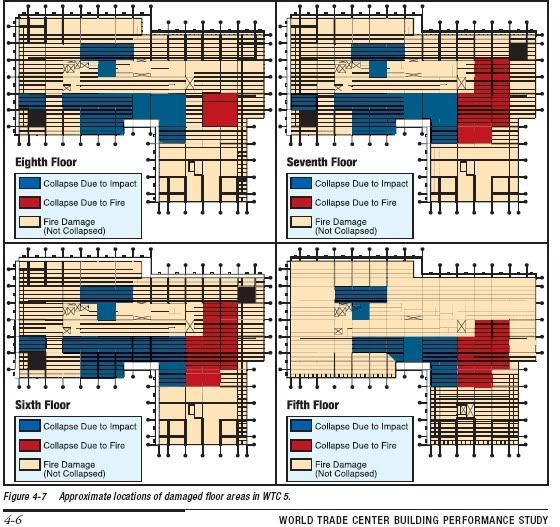 c1b) Beams in non-collapsed fire regions of building 5 show sagging, suggesting that the temperature was sufficiently elevated to weaken the steel, although not catastropically as in other regions (yellow arrows are my annotations):  c1c) A picture of a buckled column in a non-collapsed region also show that the fire temperature was sufficient to weaken the steel. The load from this column would have transferred to other columns, otherwise this area would have collapsed as well: 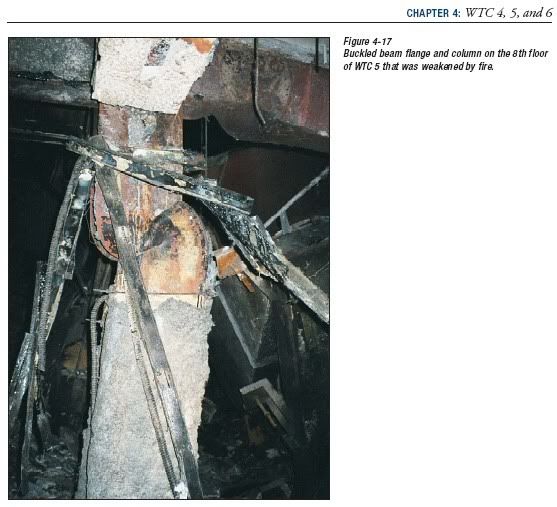 c2) A link Will posted has a graph of load-bearing properties for high-temperature steel as a percentage of strength vs. temperature. From a temperature range of 500C to 900C, the load bearing ability goes from about 70% to 10% of its ability as compared to room temperature. Steel framed buildings are built with a safety factor to account for loss of strength in a fire event, but as the images in c1) show, permanent deformation and partial collapse are still possible. 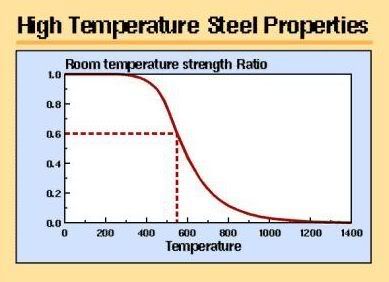 c3) WTC7's framing was unique in that not all of its columns went straight from the ground to the roof, due to the fact that it had to be build over a substation that already had caissons poured for column support, but at different locations from the eventual building 7 construction. As such, in the area between floors 5 to 7, trusses and girders were used to support columns above floor 7. This construction can be seen as a weak point should a column above floor 7 fail, especially since fires were reported in the area, and is the reason that the NIST hypothesis is that this region failed horizontally after the East penthouse collapsed. ~~~~~~~~~~~~~~~~~~~~~~~~~~~~~~~~~~ Putting together the observations:
Since the NIST analysis is not complete and is only at the hypothesis stage, do these observations provide a likely probability that the fires led to the events that occurred. At this point, I would have to say that they do. If there are other observations/evidence that point to a higher probability, let me know! |
|
|
|
|
|
#45 (permalink) |
|
Psycho
Location: way out west
|
So what you are suggesting is that all buildings should be expected to collapse in a fire and maybe having 1,000,000 square foot ranchers is the way to go for office buildings?
It's really odd that only the WTC buildings seem to collapse from fire even though there have been lots of other buildings that have had fires. But that was the day of many coincidences. I take those NIST findings with a grain of salt... OK a fifty pound bag of salt. It's making a cause to fit the results except where they can't explain, so they don't. What do you think started those fires... inside a building? The NYC emergency command center was in there... you don't think somebody could have grabbed a red bottle off the wall and put the fire out right away? |
|
|
|
|
#46 (permalink) | |||||
|
Crazy
Location: Los Angeles, CA
|
Quote:
Interestingly, I ran across some stories about steel framed buildings collapsing from fires after I last posted. I do not know the veracity of the information, but at this point have no reason to doubt them: Kadar Toy Factory Fire, May 10 1993 (http://web.archive.org/web/200703070...8&nh=0&ssect=0) 3 steel framed buildings collapsed, the cause seems to be lack of fireproofing Quote:
Roof collapse, again attributable to lack of fireproofing 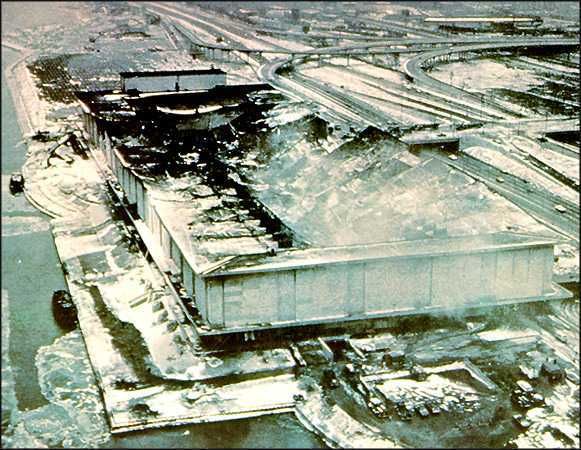 Sight and Sound Theatre, Lancaster, PA, January 1997 (http://www.interfire.org/res_file/pdf/Tr-097.pdf) Roof collapse. This building did have fireproofing on the structural members. 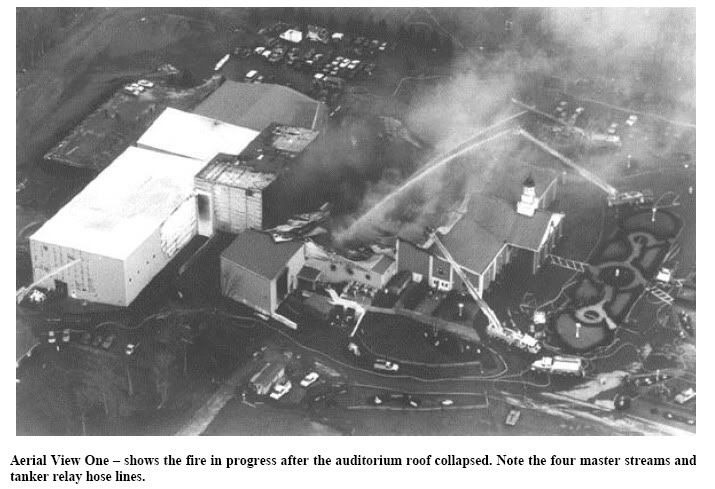 All of these buildings were rather short - the Kadar Buildings were the tallest at 4 stories. The McCormick and Sight and Sound buildings were shorter, which could explain why the walls did not fall when the roofs collapsed. It lends credibility to the hypothesis that fire *can* weaken the steel enough to cause collapse, and also lends credibility to the FEMA report that showed sections of WTC5 collapsed due to fire as well. An archived article from Fire Protection Engineering Magazine also lends support to the temperature that building fires can reach (emphasis mine): Quote:
Quote:
Hypothesis: Fire burned in WTC7 sufficiently long to weaken key structural members. ~~~~Observation: Fires burned without any fire fighting control for approximately 7 hours. Evidence from other sources indicates that temperatures can reach sufficient value to weaken steel. Hypothesis: structural members most likely on the interior of the East side failed and pancaked the floors in that area. ~~~~Observation: The east side penthouse collapsed approximately 6 seconds before global collapse began. Hypothesis: After the east side collapsed, the load was transferred to the remaining structural members, which then failed horizontally east to west. ~~~~Observation: the roofline is seen to collapse from the east to west during the global collapse. Hypothesis: the interior collapse pulled the exterior walls down at the same time, causing a compact collapse field typical of an interior failure mechanic. ~~~~Observation: The debris field *was* compact. I understand that at this point they cannot be 100% sure (and maybe never can be more than highly probable), but which cause have they not explained, at least hypothetically? Quote:
As for putting out the fire, that supposes that the buildings were still occupied. Since WTC2 collapsed before WTC1, they may have already been evacuated when WTC1 came down, but I do not know for sure. Were they to still be occupied, the next question would be at what locations the fire started - it appears from the pictures that the fire progressed South to North, indicating that they started in the South. After a bunch of debris gouged out a chunk on the south of the building, I don't know that I would stick around to check for fires at that point. |
|||||
|
|
|
|
#47 (permalink) | ||
|
Tilted Cat Head
Administrator
Location: Manhattan, NY
|
Quote:
Quote:
 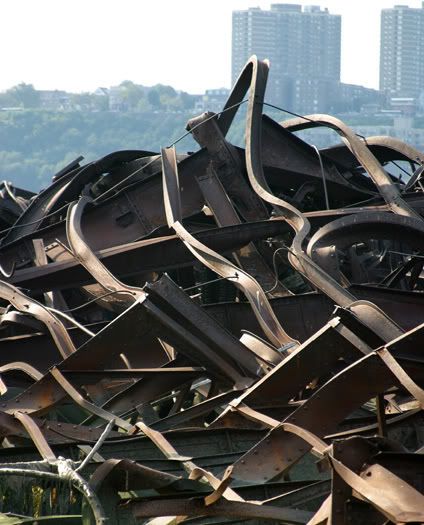 see more twisted steel from a fire http://figure-ground.com/travel/image.php?piers really? a HUGE fire and you're going to try to use a small fire extinguisher?
__________________
I don't care if you are black, white, purple, green, Chinese, Japanese, Korean, hippie, cop, bum, admin, user, English, Irish, French, Catholic, Protestant, Jewish, Buddhist, Muslim, indian, cowboy, tall, short, fat, skinny, emo, punk, mod, rocker, straight, gay, lesbian, jock, nerd, geek, Democrat, Republican, Libertarian, Independent, driver, pedestrian, or bicyclist, either you're an asshole or you're not. |
||
|
|
|
|
#49 (permalink) | ||
|
... a sort of licensed troubleshooter.
|
Quote:
Apologies, everyone, but this thread takes a lot of time. I will get to everything eventually. Responding to post #43: Quote:
 The columns that would have had to give completely in order to account for the collapse are deep in the building. There is only one photograph showing any damage, and it's not 100% trustable considering that other photographs have surfaced that contradict it. Despite this, I must concede the following point, absent any additional evidence: Asymmetrical damage could have theoretically caused a symmetrical collapse. Again, I will revisit this in greater detail when I have the time and energy. Last edited by Willravel; 02-12-2008 at 08:04 PM.. Reason: Automerged Doublepost |
||
|
|
|
|
#51 (permalink) | ||
|
Crazy
Location: Los Angeles, CA
|
Quote:
 Quote:
|
||
|
|
|
|
#52 (permalink) | |
|
Tilted Cat Head
Administrator
Location: Manhattan, NY
|
Quote:
Jun 9, 1971 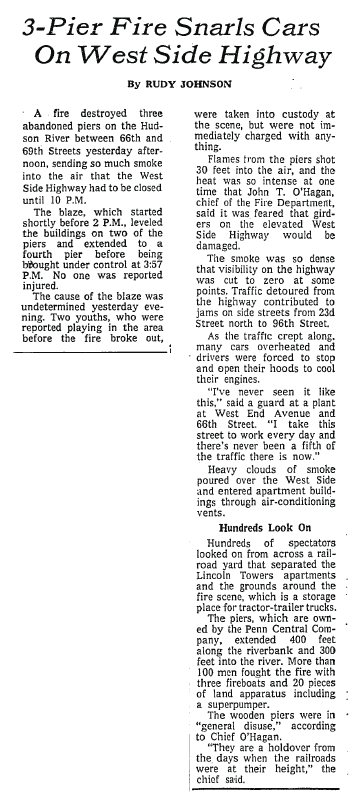
__________________
I don't care if you are black, white, purple, green, Chinese, Japanese, Korean, hippie, cop, bum, admin, user, English, Irish, French, Catholic, Protestant, Jewish, Buddhist, Muslim, indian, cowboy, tall, short, fat, skinny, emo, punk, mod, rocker, straight, gay, lesbian, jock, nerd, geek, Democrat, Republican, Libertarian, Independent, driver, pedestrian, or bicyclist, either you're an asshole or you're not. |
|
|
|
|
|
#53 (permalink) | ||||
|
Banned
|
http://web.archive.org/web/200703070...8&nh=0&ssect=0
The fires at Kader toy actually involved only two buildings, a one story building and an "E" shaped, four story building. The fire occurred in Thailand, in a relatively remote area, hindering fire fighting response time. No data on what the capabilities of the "50 pieces of firefighting equipment" actually were, or about water sources at the scene...i.e., high pressure hydrants, nearby pond, trucked in water on board fire fighting apparatus....??? The buildings were not steel framed high rise towers.... From page 2 of the above linked source: Quote:
....and early in Byrnison's post #46: Quote:
Quote:
Last edited by host; 02-14-2008 at 11:32 AM.. |
||||
|
|
|
|
#54 (permalink) | ||||
|
Crazy
Location: Los Angeles, CA
|
Quote:
You are correct that the buildings were not high rise towers, nor were the McCormick Building or the Sight and Sound Theatre. The example that Cynthetiq posted wasn't even a building really. But they were constructed with structural steel columns and rafters. In the case of the Sight and Sound Theatre, those structural members were coated with a fireproofing material, and yet the fire still raised the temperature sufficiently to cause them to fail in a relatively short time (2-3 hours). One aspect of the unanswered questions is whether the fires could have sufficiently raised the temperature to weaken the structural integrity of WTC7 - What these examples suggest is that it is indeed possible. Also remember that portions of WTC5 collapsed due to fire according to the FEMA report, and there is a picture in post #44 showing a buckled column from fire in an area that didn't collapse. I understood that the FEMA report might be viewed with a skeptical eye, so offered more examples of the capability of fire to be a collapse-initiating mechanism. Quote:
Quote:
Quote:
Additionally, based on the fact that the simulation will now include hypothetical blast events, it would seem that NIST is aware of the criticisms against it for its working hypothesis and the fact that the report is taking so long to finish, and that it has a vested interest in making sure that this report comes out, and that it contains the most probable explanation possible. As far as the contents of my posts not challenging anything that has come before, I'm not sure if you are referring to things from before in this thread or the one in Paranoia. I chose to participate in this thread because the format allows us to discuss whether the so-far hypothetical explanation for the events matches with observation, and in the case of disagreement with the hypothetical explanation allows us to make the case for another explanation that is more likely, provided we can provide evidence whether direct or circumstancial. I searched through many CT sites, debunking sites, the NIST and FEMA sites, and other backwaters linked from those sites. I make no claim that the NIST working hypothesis *is* what happened, only that to me it represents the highest possibility at this juncture, and I've laid out my reasoning as best I can. I am happy to re-evaluate or defend my reasoning should observation/evidence that represents a higher probability be presented. |
||||
|
|
|
|
#55 (permalink) | |
|
Banned
|
Two weeks ago, NIST finally released it's draft of it's report investigating the collapse of WTC 7. This is a postion of the transcript during which Dr. Sunder, lead investigator, answered questions about the report. The report determined that WTC 7 did not collapse due to damage from falling debris from other WTC towers, nor from diesel fueled fires from storage tanks, nor from explosives....but from fire initiated by impacts from falling WTC 1 debris, causing "ordinary building fires"....fueled by combustible office contents ONLY!
Quote:
Is this believable to you? |
|
|
|
|
|
#56 (permalink) |
|
... a sort of licensed troubleshooter.
|
I'm glad you brought up this fact, host. One of the more important pictures in the thread:
http://i19.photobucket.com/albums/b1..._02Gash1-a.jpg supposedly shows an area of WTC 7 to have been scooped out, and could have possibly explained the collapse (though not all that well). Now it seems that the NIST doesn't believe that structural damage from debris contributed to the collapse at all, only small fires. The fact of the matter is that, even when one assumes that fire-protected steel expands at an unreasonable rate when heat from fires are applied, it still doesn't explain the appearance of the collapse caught on video. |
|
|
|
|
#57 (permalink) | ||||
|
Crazy
Location: Los Angeles, CA
|
Since it has been nearly 7 months since we left off, I had to go back to re-read the points brought up earlier. I apologize for quoting posts previously written, but since no rebuttals were made, their contents are still game for debate.
Posts #44 and #46 contain a healthy deal of information, but some summaries are: From Post #44 (2/04/08): Quote:
Quote:
Quote:
Quote:
I understand skepticism could exist were there higher-probability scenarios to the observations provided, but to this point none have been forthcoming. To me at least, the NIST change of position that fire itself was the cause of collapse (and not the building damage) for WTC7 is something that seemed reasonable nearly 7 months ago, and it is interesting to see that it is now currently the leading suspect after NIST's analysis as well. Without rebuttals and/or competing evidence to the many pieces of information brought up in those previous posts, I am uncertain how to continue the debate. |
||||
|
|
|
|
#61 (permalink) |
|
Crazy
|
"I understand skepticism could exist were there higher-probability scenarios to the observations provided."
Several people who have posted to the thread seem to be fairly knowledgeable, if not actual engineers/architects. That's a refreshing difference to many threads like this. One very common aspect of threads such as this (but not so much this one) is that people who aren't qualified to perform any sort of structural analysis or post-mortem do so any way because they have an axe to grind. Even though I'm an engineer, I'm not qualified to add to the body of work done by the various investogators. I tend to view the whole set of events from a probabalistiv point of view, i.e. The Razor of Occam. Thanks all, for an entertaining read. |
|
|
|
|
#62 (permalink) |
|
Addict
Location: Spring, Texas
|
I finally finished reading a large amount of this thread and I can see that alot of people have done some SERIOUS homework! Thanks to Will, who even though we have disagreed on many points, I respect your candor and knowledge. What I am most curious about, is that if the facts prove that the fire could not have caused the collapse (not that I am agreeing with this, just asking here) then what DID cause the collapse? I see alot of discussion about what DIDN'T cause it, so where is the information and facts on what DID cause it?
Also, I keep hearing about people in some of the interviews and other information sites posted that people kept hearing explosions, and that some people claim that these explosions cause the collapse. My question on this is: Has anyone taken into account that EVERY building in the entire US must have a certain number of fire extinguishers per floor, and from my research it appears that most have a protective disk that prevents them from exploding, but there have been a few cases where they have. Is it POSSIBLE that the explosions were from these? I am by no means an engineer or anything of the sort. I only have an associates degree, not a B.S. or Doctorate, so forgive me if I am being a little too low-brow here in my questions. I just can read information that some people show that says that it WAS caused by a fire, but other supporting information from another source that says it WASN'T cause by fire. I know the paranoia thread is alot on conspiracy, so I am enjoying this one, but again, where is the information that shows how it DID fail, not how it DIDN'T, If it was NOT due to the aircraft impacts and resulting fires?
__________________
"It is not that I have failed, but that I have found 10,000 ways that it DOESN'T work!" --Thomas Edison 
|
|
|
|
|
#63 (permalink) | |||
|
... a sort of licensed troubleshooter.
|
Quote:
Quote:
Quote:
|
|||
|
|
|
|
#64 (permalink) | |
|
Addict
Location: Spring, Texas
|
Quote:
You say "That frame of reference has to be an agreement that the official story is not the most likely explanation, then we can move on to what is the most likely explanation." But I disagree. As a technician on cars I have learned one thing that has helped me time and time again, sometimes rather than look at what is a possibility of what might NOT have caused the problem, I like to sometimes eliminate what DOES work, and the other questions answer themselves. I do like the idea of a common frame of reference as you have stated, but it seems like not enough people can agree on one. So why not look at the abstract, and see what DOES work, instead of eliminating what one might say IS the fault? I hope I explained this properly.
__________________
"It is not that I have failed, but that I have found 10,000 ways that it DOESN'T work!" --Thomas Edison 
|
|
|
|
|
|
#65 (permalink) |
|
... a sort of licensed troubleshooter.
|
Interesting take. I hadn't thought of it like that.
The most common alternate to the official story is that of an intentional collapse. Using some method, some individual or individuals intentionally caused the collapse of the towers. This would explain WTC7 being the first steel framed building in history to fall (supposedly) due to fire, it would explain falling into it's own footprint despite apparent asymmetrical distribution of fires, it would explain how only small fires were witnessed, and it would explain the reports of explosions. Unfortunately, it begs some rather frightening questions, and that's when things generally get way, way off track in a thread like this. Someone says "controlled demolition", someone else asks "why?", they try to guess, but then the whole issue moves away from facts and gets so deep into speculation that it can become silly. I'm pretty sure aliens aren't responsible for 9/11, for example. |
|
|
|
|
#66 (permalink) |
|
Crazy
|
That's an interesting debate technique. Assume that the official version is wrong (not the most likely, by some measure or other) and go from there. It's comparable to "Assume that the earth is flat. Now let's go on to explain celestial mechanics from that point of view."
We can assume that terrorists flew airplanes into buildings, which then collapsed. In addition to eyewitnesses seeing the planes, we have the admission of the terrorists them selves. We can assume that there was some sort of government conspiracy, which provided some sort of cover that only appeared to be terrorists flying airplanes into buildings. Maybe it isn't the best starting point you have there. Maybe you would want to start with evidence. You know, the conspiracy theories only gain traction when you make an assumption such as the NIST investigation was all a sham. |
|
|
|
|
#67 (permalink) | ||
|
... a sort of licensed troubleshooter.
|
Quote:
Post #65 was an aside in which I tried to illustrate why evidence based discussion was necessary. Quote:
|
||
|
|
|
|
#68 (permalink) |
|
Crazy
|
I was responding to post 63: "That frame of reference has to be an agreement that the official story is not the most likely explanation, then we can move on to what is the most likely explanation." My apologies for taking it out of context. Most conspiracy threads do just that.
My belief is that the typical layman hasn't the access or the skill set to do building failure analysis, though many, many attempt to do just that. My personal assessment of the whole thing is probability-based. |
|
|
|
|
#69 (permalink) |
|
The sky calls to us ...
Super Moderator
Location: CT
|
You guys are doing OK, just make sure to keep the tone of the thread respectful and productive. I killed the rules since I think we'll do OK without them.
If it gets sidetracked, we can always make another thread for other discussions. Let's keep this one to discussions of hard evidence rather than questioning premises and motives. Last edited by MSD; 09-24-2008 at 08:38 AM.. |
|
|
|
|
#70 (permalink) | |
|
|
Quote:
I agree we have to have a common frame of reference if we want to get anywhere. The problem that I have is that you jump right to: "That frame of reference has to be an agreement that the official story is not the most likely explanation" I think that from what I have seen from almost every thread on the Politics board is that this is a step too far and too quick. I believe that we have to build the common frame of reference - in the case of this topic by examining things one at a time, coming to agreements on any conclusions, and thenmoving on to the next issue. In fact, it seems as thought this thread has been successful so far because we are doing just that. If we can agree on items one by one then we can build a common frame of reference. The problem with every other thread that gets nowhere and goes in circles over and over is that everyone comes to the thread with their own version of what the common frame of reference should be (or what is obviously apparent) and tries to tell everyone why it is so. I think that we are doing something different (speacial) in this thread. We may all be coming to this thread with our own belief of what the common frame of reference should be but we are putting it on the side (maybe temporarily or maybe permanently) while we try to investigate items one by one. Hopefully we can agree on some of these items and then add them to our collective common frame of reference. Do you see the point I am trying to make?
__________________
Sticky The Stickman |
|
|
|
|
|
#71 (permalink) |
|
... a sort of licensed troubleshooter.
|
If we can't agree that the official story is not the most likely explanation for any of the evidence, there's no use talking about any conspiracy theories at all because they'll be assumed by one side and dismissed by the other. In effect, my method is your method: building a common frame of reference by addressing the question one piece of evidence at a time. Once there's enough evidence that people generally agree that the official story isn't the most likely explanation, then the thread has done what I intended. Likewise, if the opposite has happened, where most of the evidence is thoroughly studied by each side and the consensus is that the evidence does support the official story, we can share this information with other people that don't believe the official story.
The end result should be truth either way, after all. |
|
|
|
|
#72 (permalink) |
|
|
Perfect.
All I ws trying to say was I don't think that we have that common frame of reference yet and that this thread (hopefully) will help build one. What it is? who knows. At this point to say that the common frame of reference HAS to be X would nullify anything we are trying to do in this thread. It may take us a very long time to build this common frame of reference. It may take us a very long time to agree on even one thing (I am not sure we have yet). Maybe we should think of a way to track what we agree upon as we move forward.
__________________
Sticky The Stickman |
|
|
|
|
#73 (permalink) |
|
Crazy
|
What you guys are describing as a "common frame of reference" is really an outcome, in my mind.
One approach might be to analyze the documentation one item at a time, with an open mind. These items would include the various "official" investigation reports as well as the numerous "unofficial" ones, like the various building collapse analyses, video examination discussions, etc. At the end of the day (or whatever time period) each item might be generally accepted or rejected, and the final body of evidence would indicate the truth. I think this is what you guys are trying to do, right? One problem with this approach is the difficulty in getting concensus on what to reject and what to accept. For example, in the free-fall discussion endlessly debated in so many of these threads, a discrepancy of a few tenths of a second causes some to conclude that the real cause was aliens and micro-nukes. It's hard to accept that if a document contains a small error or fallacy, then the whole is or is not suspect. Since my personal opinion is based on probabilities and not a detailed scrutiny of the thousands of documents available, I think I'll back out and leave you to it. I'll lurk, though, because a lot of thought and work is going into your posts. |
|
|
|
|
#74 (permalink) |
|
Psycho
Location: way out west
|
If you just assume you are doing the same as the official theory.
Many facts were ignored if they didn't fit that preconcieved theory. That's how we end up with things like some of these supposed 19 hijackers still being alive and the planes they supposedly crashed still being flown years later. The idea of 19 Saudis having hijacked planes is a conspiracy theory without solid evidence to prove it. Much of what is still being used to support that case has been recanted. Check for yourself, are the Barbara Olson phonecalls legit? FBI says there was no call. No call means the story of the boxcutter hijack isn't based on any reality. |
|
|
|
|
#75 (permalink) |
|
Crazy
|
fastom, you can pick any particular fact and dispute it. Depending on which websites you read, and which authors you trust, you can have any number of facts confirmed or denied. Most arguments, in my reading on the subject, do just this. They identify a list of facts that they can somehow dispute and then go on to declare that all official reportage must then be suspect because of it.
For myself, I have no way of establishing whether any of the 19 terrorists are still alive, unless I read something and choose to believe it. The list goes on. The way I approach the whole issue is to assess the probabilities. In a nutshell, what are the chances that the US government or some part of it could pull off such a massive conspiracy and not leave behind all sorts of clues, turncoats, etc. to prove it? If such a conspiracy could really be proven, it would be the news story of the millennia. Wht hasn't someone with credibility (not Rosie O or Willie Nelson) come forward with witnesses willing to testify. Instant fame and wealth, you know? Woodward and Bernstein will be in the history books for years for breaking the news of a hotel breakin. |
|
|
| Tags |
| 9 or 11, attacks, questions, surrounding, unanswered |
|
|